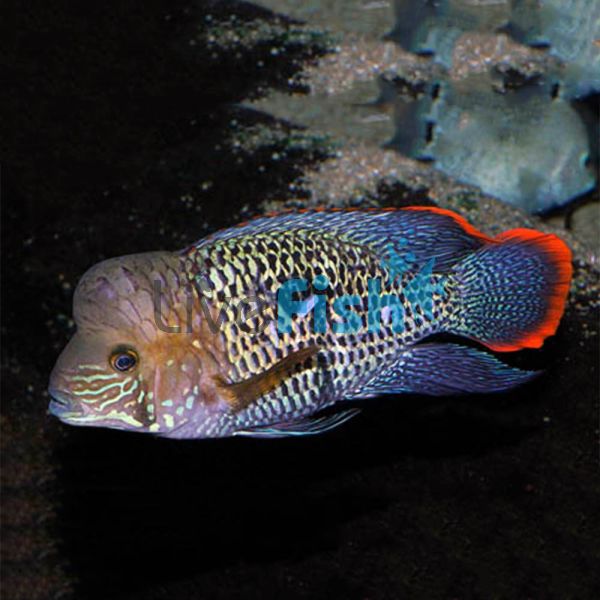Aequidens Rivulatus Gold Saum 3.5cm
Also known as Gold-edged.
The Gold Saum, also commonly known as the Gold Edge Green Terror, is one of the most iconic and visually striking cichlids in the aquarium hobby. Despite their intimidating name, Gold Saums are often more manageable than their "terror" label suggests, especially when given adequate space and suitable tank mates. Their bold colours, impressive size, and flowing fin extensions make them a fantastic choice for aquarists looking for a large, centrepiece fish.
- Buy 2 for $12.97 each and save 10%
- Buy 4 for $11.53 each and save 20%
- Buy 6 for $10.09 each and save 30%
Aequidens Rivulatus Gold Saum
The Gold Saum, also commonly known as the Gold Edge Green Terror, is one of the most iconic and visually striking cichlids in the aquarium hobby. Despite their intimidating name, Gold Saums are often more manageable than their "terror" label suggests, especially when given adequate space and suitable tank mates. Their bold colours, impressive size, and flowing fin extensions make them a fantastic choice for aquarists looking for a large, centrepiece fish.
The Gold Saum stands out with its deep metallic green body, which shimmers with hues of blue under good lighting. However, what really makes this fish famous is the bright golden-orange edging that outlines the dorsal and tail fins. As they mature, this golden edge becomes even more pronounced, making the Gold Saum look like it's been hand-painted with gold leaf. Males, in particular, grow larger and can develop a nuchal hump similar to a flowerhorn when fully mature, adding to their commanding appearance.
Breeding Gold Saums in captivity is achievable and quite rewarding for dedicated aquarists. Males and females can be paired off naturally if raised together, but once a bond is formed, they can become extremely territorial during spawning. Gold Saums are substrate spawners, typically laying their eggs on a flat stone or a carefully cleaned section of the aquarium floor. After courtship, the female lays eggs, and both parents will guard and fan the eggs vigorously. Once hatched, the fry can be raised on freshly hatched baby brine shrimp or powdered fry food. It's important to ensure that the breeding pair has plenty of space and that tank mates are removed during spawning to avoid aggression.
Tank Recommendations for your Gold Saum - Gold Edge
Gold Saums are large, robust fish that require a minimum tank size of 300 litres for a single adult specimen. If planning to keep a pair or house with other cichlids, an even larger tank with a good footprint is necessary. A sand or fine gravel substrate is ideal, and the addition of sturdy driftwood, large rocks, and tough plants like Anubias or Java Fern will make them feel at home.
These cichlids appreciate places to claim as territory, so creating natural divisions in the aquarium can help reduce aggression. Gold Saums prefer slightly acidic to neutral pH and temperatures around 24-28°C. A tight-fitting lid is also recommended, as large cichlids can be surprisingly good at jumping.
Suitable Tank Buddies
The Green Saum is semi-aggressive by nature, and while they can be kept peacefully in community settings when young, they may become territorial as they mature, especially during breeding. With adequate space and careful selection of tank mates, they can coexist successfully with a range of robust species.
Usually Compatible
Other medium to large South American cichlids such as Severums, Uaru, Jack Dempseys, Geophagus species, large peaceful catfish like Synodontis, and robust schooling fish such as Silver Dollars.
Sometime Compatible
Oscars, Firemouth, and jaguar cichlids, along with similar semi-aggressive species.
Rarely Compatible
Small, delicate fish like tetras, guppies, or dwarf cichlids, which would become prey to these fish.
Feeding your Gold Saum - Gold Edge
Green Saums are not fussy eaters and will readily accept a variety of foods. For optimal health and colouration, they should be fed a varied diet consisting of high-quality cichlid pellets, supplemented with frozen or live foods like bloodworms, brine shrimp, and krill. Offering vegetable matter such as spirulina flakes or blanched spinach can also help balance their diet.
| Scientific Name | Andinoacara Rivulatus |
|---|---|
| Care Level | Moderate |
| Common Names | Green Saum, Gold Edge Green Terror |
| Diet | Carnivore |
| Fish Family | Cichlidae |
| Lifespan (years) | 10 |
| Max. Length (cm) | 20 |
| Min. Tank Volume (l) | 250 |
| Origin | South America |
| Sociability | Semi-aggressive |
| Venomous | No |
| Water Conditions | 24-26° C, pH 6.5-7.5 |
| Plant Safe | With Caution |




